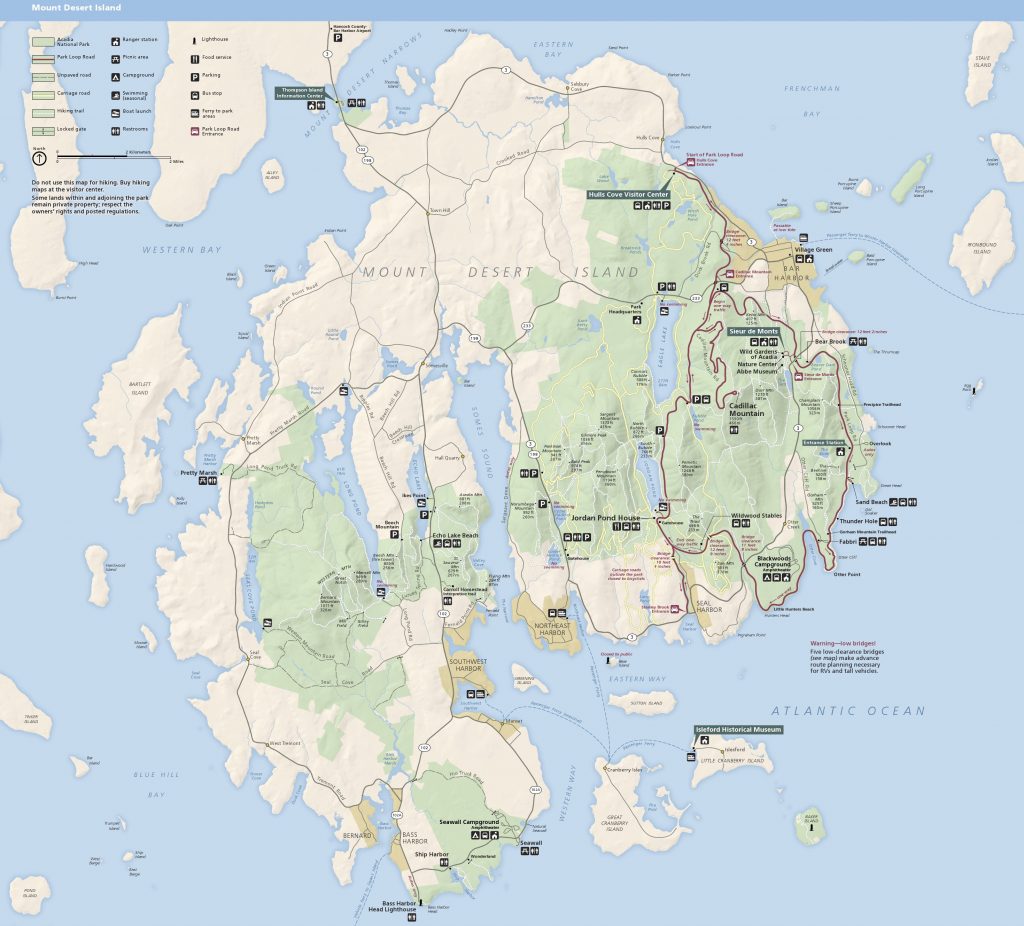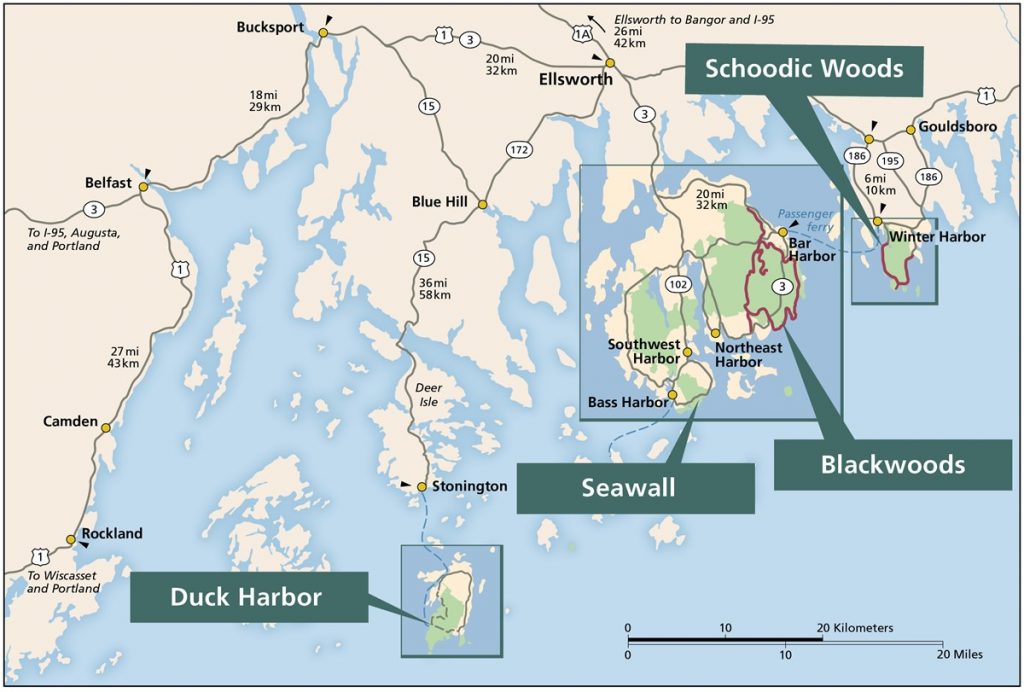Introduction
“Acadia National Park protects the natural beauty of the highest Rocky headlands along the Atlantic Coastline of the United States, an abundance of habitats, and a rich cultural heritage.
At 3.5 million visits a year, it's one of the top 10 most visited national parks in the United States. Visitors enjoy 27 miles of historic motor roads, 158 miles of hiking trails, and 45 miles of carriage roads.” - National Park Service
Acadia National Park is based on Mount Desert Island along the coast of magnificent Maine- also known as “Vacationland.” Thus, it’s the perfect destination for your next vacation!
Location / Directions
Acadia National Park is located on Mount Desert Island on the northern coast of Maine, 264 miles from Boston, Massachusetts, and 50 miles from Bangor, Maine.
The best driving route to take to Acadia from the south
There are two routes:
Take I-95 north to Augusta, Maine; from Augusta take Route 3 east to Ellsworth and on to Mount Desert Island.
Take I-95 north to Bangor, Maine; from Bangor take Route 1A east to Ellsworth; from Ellsworth take Route 3 to Mount Desert Island.
What if I don’t have a vehicle?
If you don’t have a car to venture around the park, don’t worry. The Island Explorer Shuttle Bus operates from June 23 through early October. This free service features 10 bus routes linking hotels, inns, and campgrounds with destinations in Acadia National Park and neighboring village centers. Visit the Island Explorer website for more information.
Island Explorer Shuttle Bus Covid Update:
The Island Explorer service for Acadia National Park and surrounding communities has been postponed indefinitely in response to the COVID-19 pandemic. Please contact Paul Murphy, Executive Director at Downeast Transportation, Inc. at (2070 667-5796 with questions or concerns.
What is there to do in the park?
Acadia is suitable for your typical outdoor enthusiast and nature-lover due to its miles of shoreline, 158 miles of hiking trails, and 45 miles of carriage roads to walk and bike.
The park is known for activities like biking, hiking, and horseback riding, while Kayaking and canoeing are also popular.
In the summer, two beaches offer the opportunity for swimming or perhaps just relaxing on the sand. Acadia also offers ranger-led programs that will inform you of the park’s history (currently suspended due to Covid).
When is the best time to visit Acadia?
Acadia National Park is a spectacular destination year-round, but crowds gather in the Summer season from June to August. Summer is an ideal time to visit due to the sunny weather as this allows visitors to enjoy the dazzling beaches.
Many prefer to visit Acadia National Park in the fall, especially in a venture to observe the beautiful fall foliage. Regardless of when you plan to visit, prepare to stay in the park for about three to four days to fully experience the many wondrous features that Acadia has to offer.
How much does it cost to enter Acadia
From May through October, all Acadia National Park visitors are required to have a park entrance pass. All vehicles must display a park entrance pass clearly visible through the windshield.
Weekly passes are $30 per vehicle and are valid for seven days. If you’re entering the park without a vehicle (this includes hikers and bikers), the cost is $15 per person and is also valid for seven days. If you have children under 15, there is no charge for them.
If you’re thinking of visiting Acadia more than once this year, consider investing in the Acadia Annual Pass which costs $55 and is valid for 12 months. This pass will admit the pass holder and passengers in any non-commercial vehicle.
Due to COVID-19, Acadia is limiting in-person pass sales in the park itself. Your best bet is to purchase your pass online at thtps://www.recreation.gov/sitepass/74271
Once you have purchased your pass online, print it out. When you get to Acadia, you should display it on the dashboard of your vehicle.
Covid Update:
Vehicle Reservations Planning Underway
Visitors to Acadia National Park will need a vehicle reservation to drive up the Cadillac Summit Road during sunrise and daylight hours for the 2021 summer season. Details about reservation dates, costs, and sales procedures are expected to be announced early in the new calendar year.
Vehicle reservations will not be required for the Sand Beach Entrance corridor in 2021.
Top 11 destinations in Acadia National Park and surrounding areas!
1. Cadillac Mountain
Towering in at 1,530 feet in height, Cadillac Mountain is the tallest mountain in Acadia and the tallest mountain on the North Atlantic seaboard.
Visitors can drive up Cadillac Summit Road, located off the Park Loop Road, which is a windy, but paved 3.5 miles road up to the summit.
No RVs or trailers are allowed up Cadillac Summit Road. You will likely spot bikers travelling up and down the summit as you venture up.
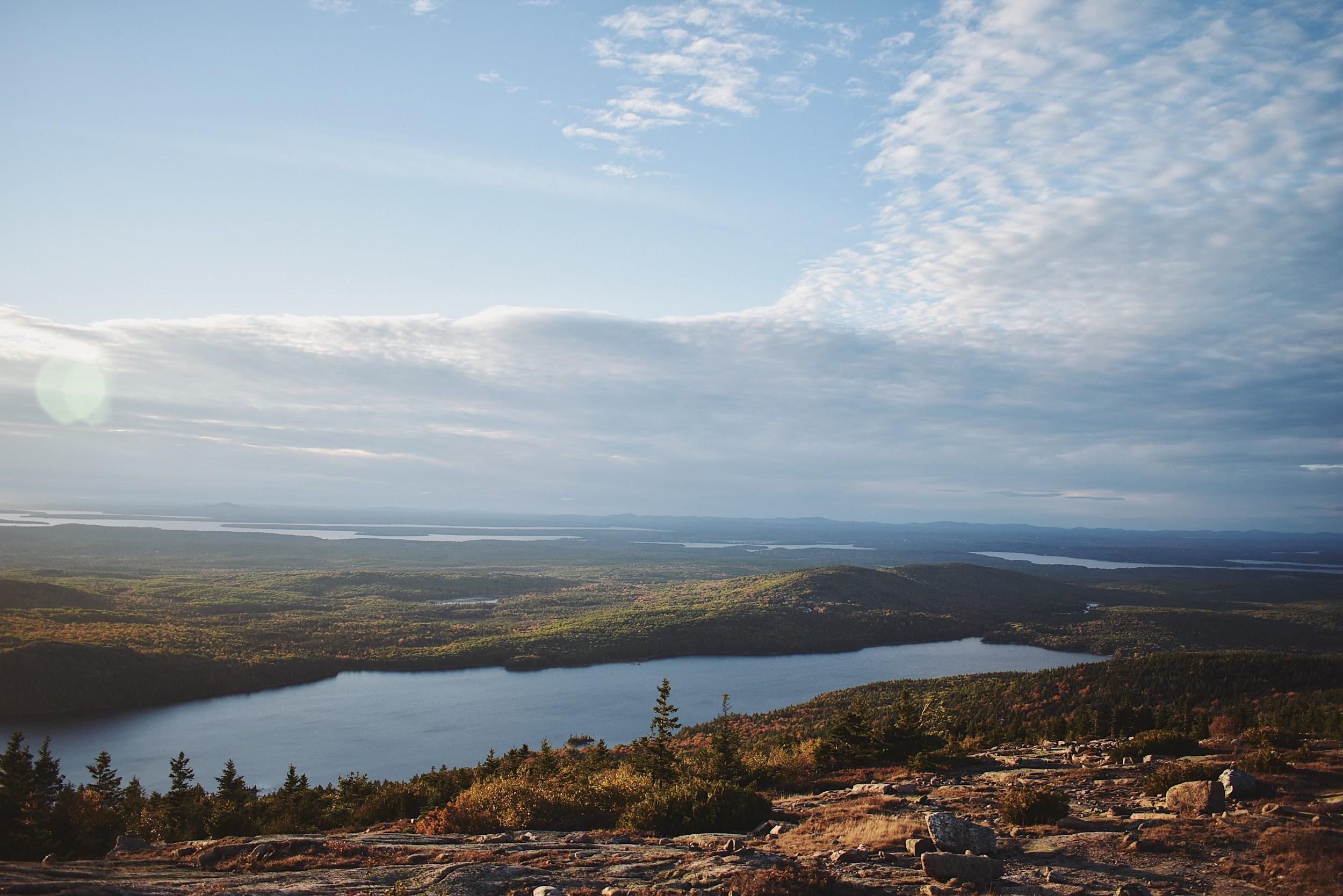
It’s recommended to visit Cadillac Mountain early to avoid crowds and experience the sunset. Sunsets here are heavenly because Cadillac Mountain is the first point in the U.S. to view the ascending sun from early October to early March.
2. Sand Beach
Because of the exquisite and ethereal views at Sand Beach, it’s the most popular of Acadia’s beaches. Nestled between granite and the magnificent evergreen forest, the beach provides wondrous swimming into teal blue waters.
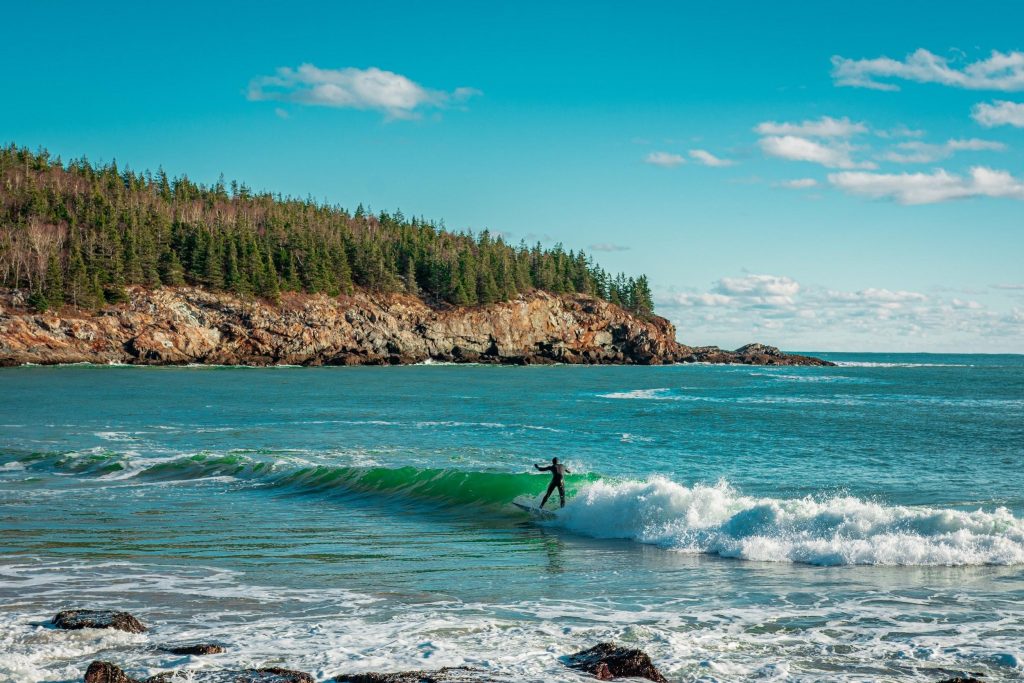
When you’re done swimming and sun-tanning, the Great Head Trail is a great 1.4 mile climb up granite steps that provides a breathtaking view of Sand Beach.
3. Bass Harbor Head Lighthouse
Looking to catch a sight of dolphins and seals while you’re visiting Acadia? Then Bass Harbor Head Lighthouse is the perfect destination for you! The lighthouse was first built in 1858 and provides the ideal spot for a family photograph in front of the entrancing historic lighthouse.
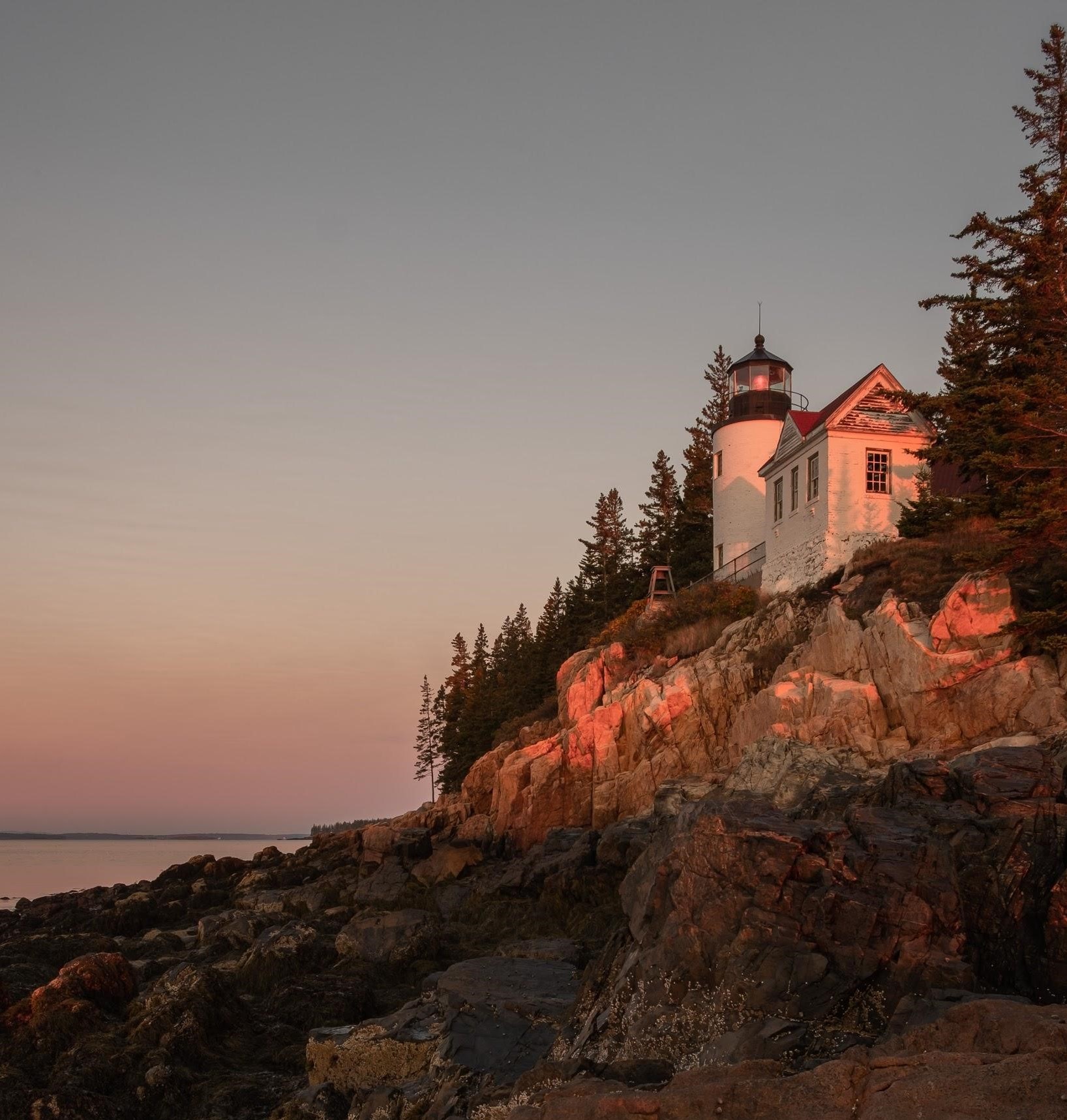
Unfortunately, visitors are prohibited from entering the lighthouse, but there is a walkway that brings you to a viewing platform that offers spectacular views of the lighthouse (and wildlife).
4. A Hike to Bar Island
One of the most unique destinations at Acadia National Park is far less known. For 1.5 hours before and after low tide, a gravel bar is exposed to form a natural land bridge connecting the town of Bar Harbor and Bar Island. This allows you hike to the island that, during high tide, you’d have to take a boat to get to.
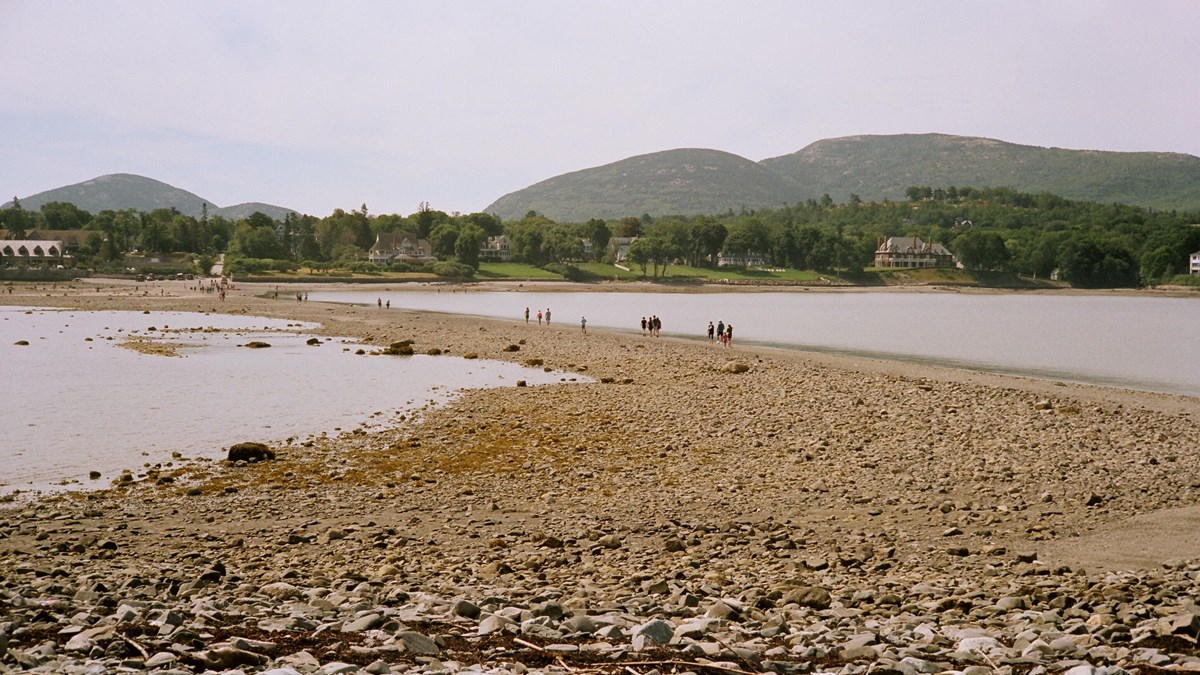
After crossing the sandbar, we recommend you take the short, family-friendly climb to the top of Bar Island which will provide you with a beautiful view of the mountains.
Be careful though! If you walk over to the island and lose track of time, it is 9 hours until the bar emerges again to safely walk across. The alternative is ordering a “water taxi” to come rescue you! It will cost you a pretty penny, too- $150.
5. Bar Harbor
Shopping, restaurants, and entertainment, oh my! Just a short drive away from Acadia is the bustling town of Bar Harbor.
Charming and captivating would be the best ways to describe the delicate, but busy town of Bar Harbor. Referred to as the gateway to Acadia National Park, Bar Harbor exhibits water views to watch boats pass by, shopping, and delicious food. People of all ages and interests will enjoy the sights and shops of exquisite Bar Harbor.
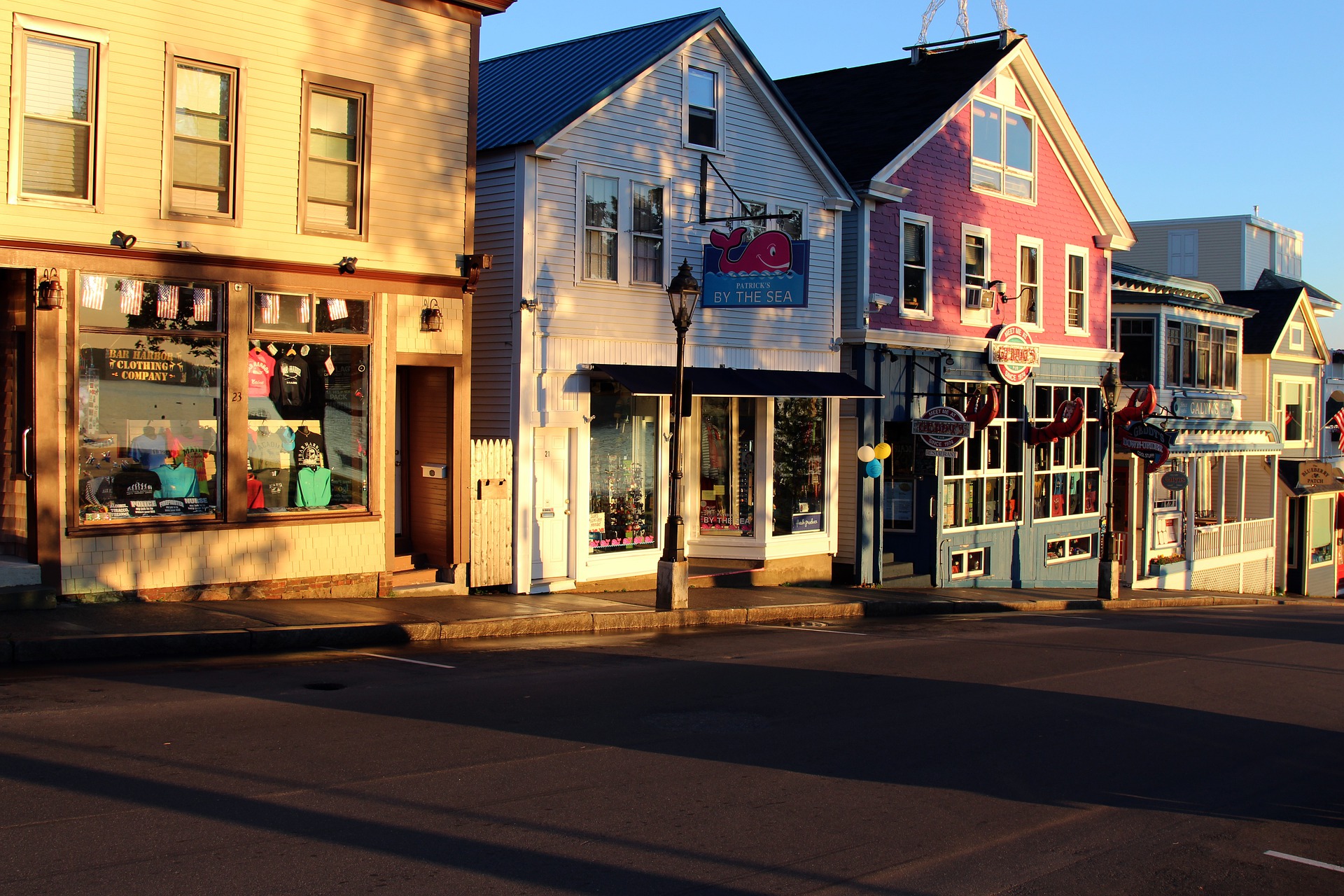
This is the ideal spot to enjoy your “mandatory” lobster meal. After your lobster and blueberry pie, you can lay out on the lawn before continuing your shopping.
If you’re interested in adventuring on a whale-watching trip, many are available in Bar Harbor.
6. Jordan Pond
Jordan Pond is a small mountain lake (also known as a tarn) formed by a glacier. It is known for its immaculate clear waters that mirror the mountains that encompass the pond. While you can’t swim in Jordan Pond, you can bring your canoe or kayak.
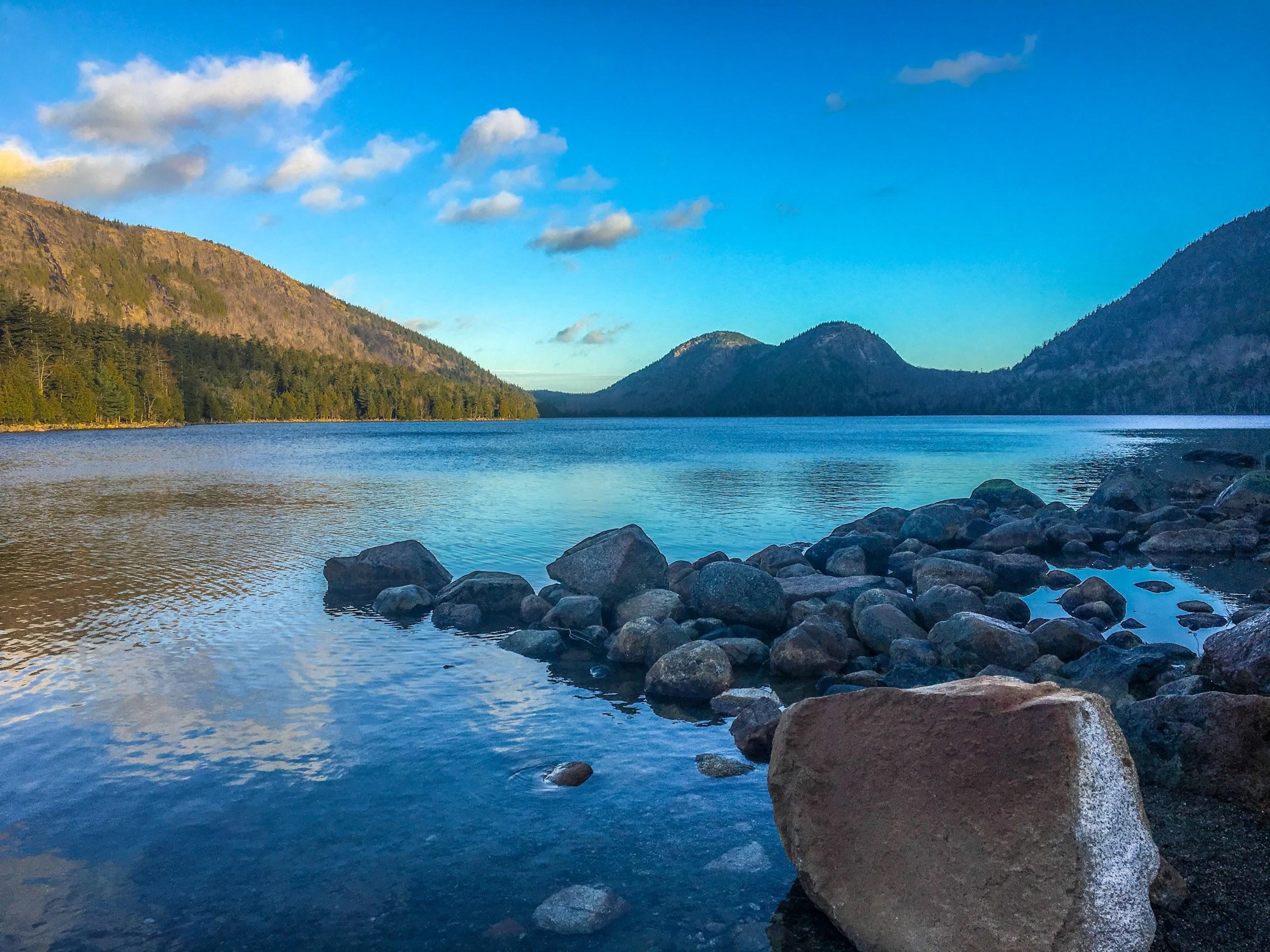
A popular hike is the Jordan Cliffs Loop- a 5 mile hike for experienced hikers that brings you face-to-face with iron rungs, steep slopes, and then uphill to Sargent Mountain. The view of Jordan Pond nestled between two mountain summits is worth the ambitious climb.
7. Carriage Roads
The Carriage Roads encompass 57 miles of paved paths that were formed and funded by John D. Rockefeller Jr.
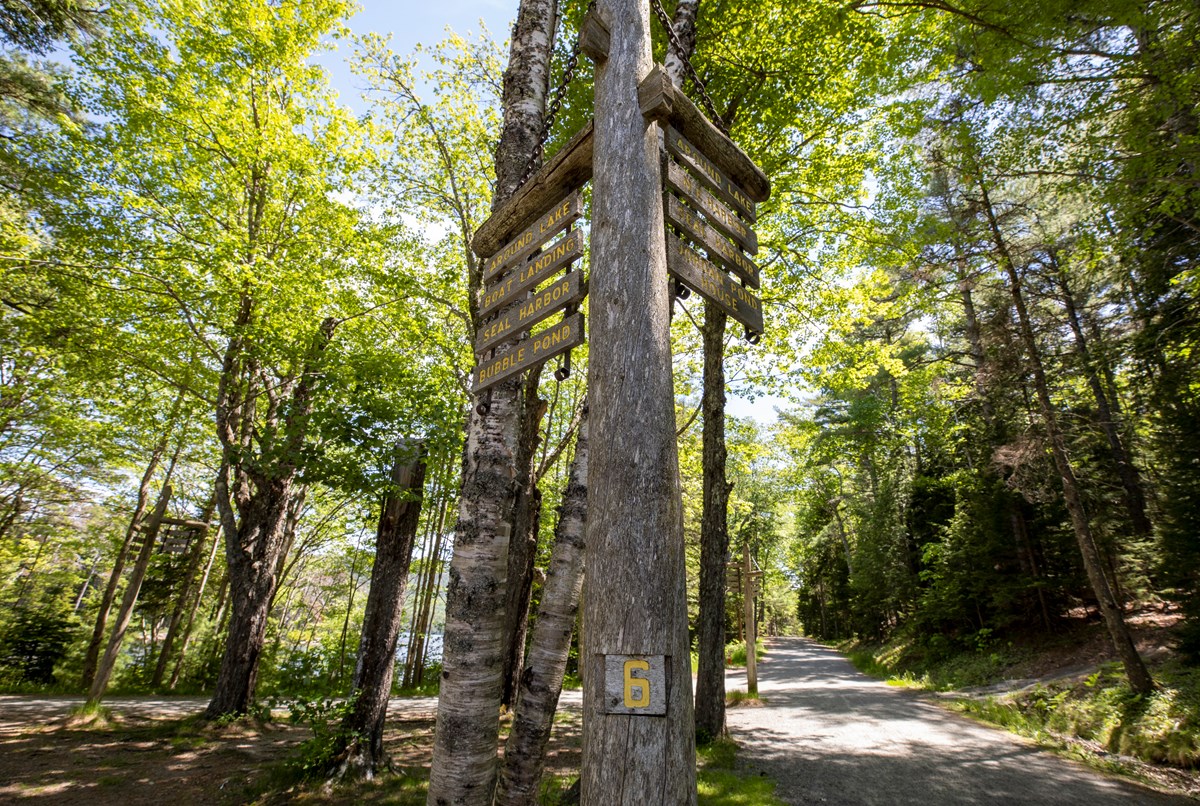
Vehicles are prohibited which make the Carriage Roads ideal for walking, biking, and horse-back riding. One unique feature of the Carriage Roads is the opportunity to book a horse-drawn carriage ride, however, we encourage you to reserve a spot early since this is a popular activity.
In the winter, the Carriage Roads are open for skiing and snowshoeing.
8. Thunder Hole
Known for its booming sound that imitates thunder, Thunder Hole is a natural inlet. At the end of the inlet is a cavern. Around high tide, when the cavern and the ocean meet as waves pervade into the cave, air and water is forced out of the cave. That action produces a loud sound similar to thunder.
As a result of the quarrel between the cavern and ocean waves, water is known to spray as far and high as 40 feet! So be careful- you might get wet if you’re not careful.
9. Otter Cliff
Otter Cliff is a giant 110-foot-high granite headland or precipice. It is one of the tallest cliffs along the Atlantic Coast. Otter Cliff provides a beautiful overlook of the ocean.
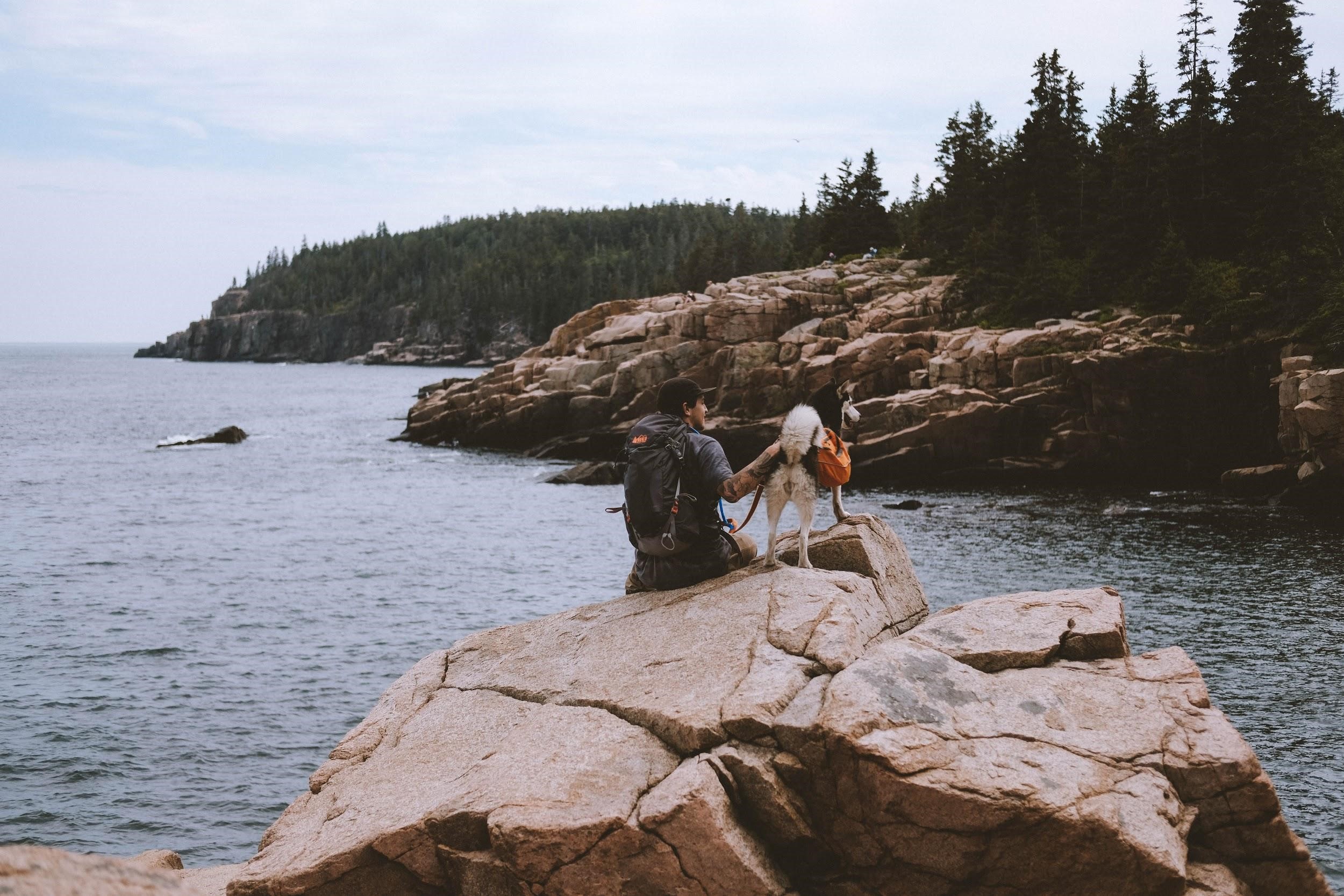
To reach Otter Cliff, there is a trail known as the Ocean Path that you can follow to experience panoramic views of Acadia.
10. Bubble Rock
A popular hiking destination in Acadia is a large boulder perched on a cliff overlooking Jordan Pond. It’s one of the most popular and visited areas in Acadia National Park. Perched precariously on the edge of the summit of South Bubble, this colossal geological feature is an example of a glacial erratic, a huge rock that was moved here by the actions of ancient glaciers.
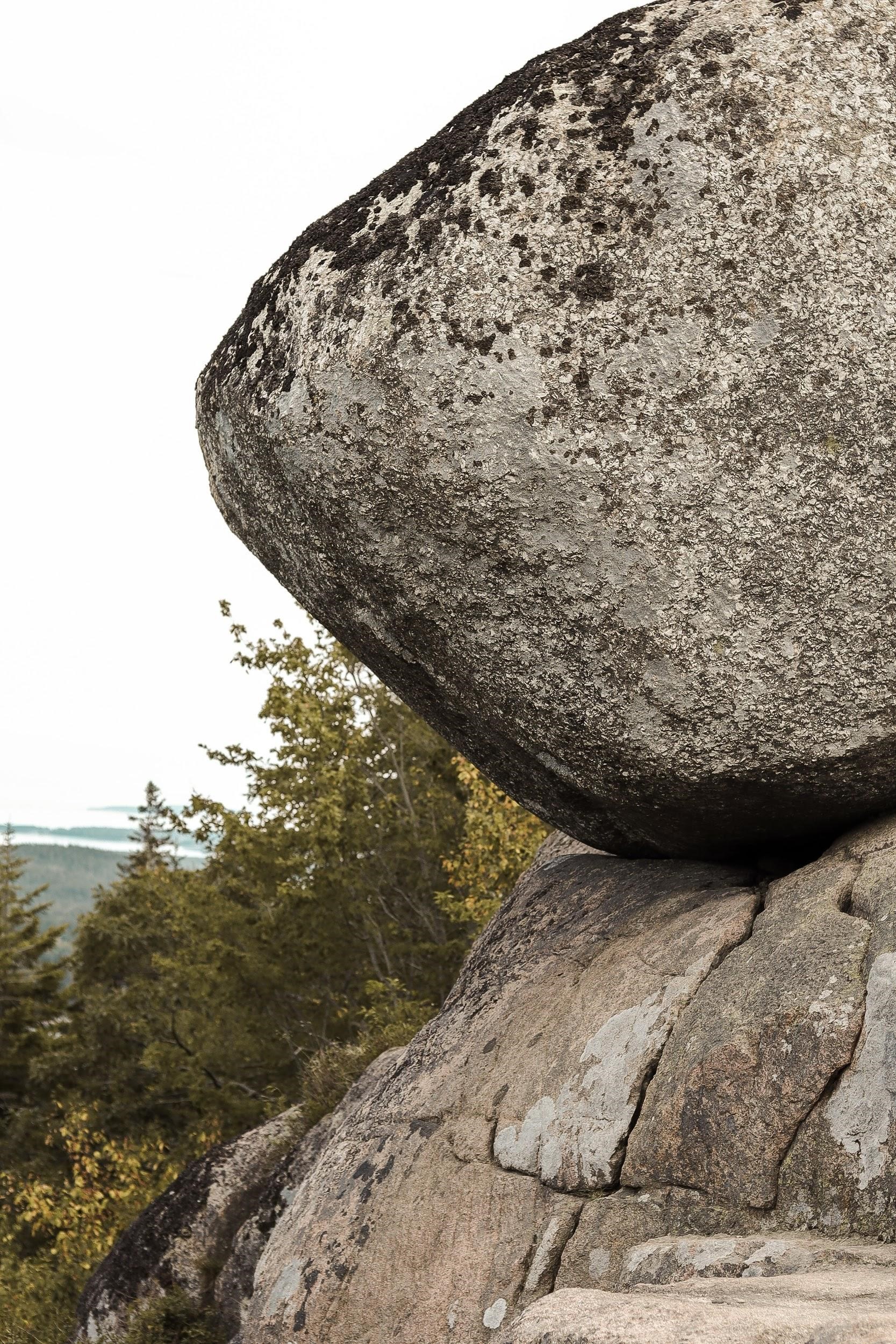
To experience the profound awe of Bubble Rock and the 768-foot peak of South Bubble, follow the Bubbles Divide Trail and Bubbles Trail.
11. Don’t Forget About Camping!
There are four designated campgrounds within Acadia National Park (see map and location / driving directions below):
Blackwoods Campground
Seawall Campground
Schoodic Woods Campground
Duck Harbor Campground
If you’re interested in being close in proximity to the park and Bar Harbor, check out Blackwoods Campground. On the other hand, Seawall is typically less crowded. If you’re in for an adventure, Duck Harbor is located on a more remote island called Isle au Haut and is only accessible by boat.
Please note that bringing your own firewood is not permitted. Please expect to buy firewood near Acadia.
Note: Camping is only permitted at designated campgrounds within Acadia National Park. There is no backcountry camping, "out-of-bounds" camping, or overnight parking allowed.
Finding a campsite at one of the four campgrounds upon arrival to Acadia is a rare occurrence during good weather. There are no first-come, first-serve sites. All campsites are by reservation only.
You can make your reservation up to two months in advance here:
Acadia National Park Campgrounds - Recreation.gov
BlackWoods Campground
Latitude 44° 18' 34.9999" N Longitude 68° 12' 29.0002" W
The entrance to Blackwoods Campground is off of State Highway 3, six miles south of Bar Harbor. There is no entrance to the campground from Acadia National Park's Park Loop Rd. The Park Loop Rd. has several low bridges and the majority of it is one way traffic; do not enter any entrances with a vehicle or equipment that is 10'4" or more.
Seawall Campground
Latitude 44° 14' 19.0000" N Longitude 68° 18' 10.0001" W
Seawall Campground is located in breathtaking Acadia National Park on the western side of Mount Desert Island on the Maine Coast. The campground is approximately 18 miles from Bar Harbor and the park loop road.
From Boston, take I-95 north to Augusta, Maine, then Route 3 east to Ellsworth and on to Mount Desert Island.
For an alternate route, continue on I-95 north to Bangor, Maine, then take Route 1A east to Ellsworth. In Ellsworth, take Route 3 to Mount Desert Island.
At first traffic light on Mount Desert Island, bear right onto Route 102. Stay on 102 for approximately 11.5 miles. You will pass through Somesville and the town of Southwest Harbor. As you leave Southwest Harbor, turn left onto Route 102A and travel approximately 3.5 miles. Campground entrance is on the right.
Schoodic Woods Campground
Latitude 44° 22' 53.3798" N Longitude 68° 4' 6.1000" W
Schoodic Woods Campground is located on the Schoodic Peninsula, 1.5 miles (2.5 km) southeast of Winter Harbor. It is approximately 60-70 minutes from Bar Harbor and the main section of the park.
Take I-95 north to Bangor, Maine, then take Route 1A east to Ellsworth. In Ellsworth, head north on U.S. Route 1 for approximately 17.3 miles to Hwy 186. Turn right on Hwy 186 and drive 6.5 miles. Turn left at yield sign, continue .5 miles and turn right on Schoodic Loop Road. Take Schoodic Loop Road for 1.0 mile. Campground will be on your left. GPS Address: 54 Farview Dr. Winter Harbor, ME 04693
Duck Harbor Campground
Latitude 44° 1' 41.5099" N Longitude 68° 39' 11.2399" W
Duck Harbor Campground is located on Isle au Haut, a rugged island off the coast of Stonington, Maine. Remote and inaccessible to automobiles, Isle au Haut is linked to the mainland by mailboat.
From the north, take I-95 to Bangor, then I-395 to Brewer, then take Rte. 15 south to Stonington. From the south, take I-95 or I-295 to Augusta, then Rte. 3 to Belfast, then Rte. 15 to Stonington.
Bringing Your Dog To Acadia?
Great! Here’s everything you need to know:
Acadia National Park has a “Bark Ranger program” which informs dog owners of the Rules of B.A.R.K. while visiting Acadia with a lively pet.
What are the Rules of B.A.R.K.?
B = Bag Your Poop
A = Always Wear a Leash
R = Respect Wildlife
K = Know Where To Go
Note: Service dogs or sight-guiding dogs may accompany their owner to all park locations unless the area is closed to all visitors.
Pets must always be on a leash no longer than 6 feet (2 m). This includes the prohibition of retractable leashes that extend beyond 6 feet. Leashes will assure your dog’s safety in the park. Leashes aid in assuring dogs don’t get lost, as well as protect them from dangers of the wilderness (i.e. porcupines). Having your dog on leash keeps you, your dog, other people, and animals safe.
Keep your dog at a distance from wildlife at all times (this rule also applies to us humans). Dogs are capable of chasing and endangering wildlife.
Pets should never be left unattended!
Please be aware that there are 100 miles (161 km) of hiking trails and 45 miles (72 km) of carriage roads where pets are allowed. Blackwoods, Seawall, and Schoodic Woods campgrounds also permit pets.
All public buildings and the beaches at Echo Lake and Sand Beach from May 15–October 15 do not permit pets. For a full list of areas that do not permit pets, visit the NPS’s website.
Hikers, many park trails will not be suitable for your pets because of how steep they ascend. The terrain becomes very challenging, and very much impossible, for pets to navigate themselves.
Remember that a little preparation goes a long way. Think heavily about your pet’s experience in the park beforehand so that you have everything you need.
Bring enough (in fact, bring extra) water for you and your pet. Be 100% certain that your pet has the endurance and paw protection to hike. If your pet is older, or has medical conditions, please reconsider long or strenuous hikes as this could be a danger to your dog. Especially if you’re unfamiliar with Acadia, it’s natural to get lost or lose track of time, so be prepared for those situations with your four-legged friend.
Now get out there, and cherish the realm of beauty that is Acadia National Park!
Restricted Areas
Most lakes in the park are public water supplies. Pets and people may not swim in them.
Park Trails Closed to Pets
Precipice
Beehive
Ladder Trail to Dorr Mountain
Beech Cliffs Trail
Perpendicular Trail (Mansell Mountain)
Jordan Cliffs Trail between Penobscot East Trail and the carriage road
Park Trails Not Recommended For Pets
Acadia Mountain
Flying Mountain
Giant Slide
Cadillac Mountain- west face
Bubble and Jordan Ponds Path, between the carriage road and The Featherbed pond
Norembega Goat Trail
Bubbles-Pemetic Trail
Penobscot Mountain (Spring) Trail
Upper Beachcroft Trail
Upper Gorge Trail
Are there Restaurants within Acadia?
The Jordan Pond House Restaurant is the only restaurant directly located within Acadia National Park.
This bustling restaurant overlooks Jordan Pond and is well known for its afternoon tea, popovers (a type of roll) and of course, seafood!
Be aware of long wait times. If you’re not willing to stand in line, https://www.visitbarharbor.com/ lists these dog-friendly dining options:
- Atlantic Brewing & Mainely Meat BBQ – on the patio
- Beal’s Lobster Pier
- Chartroom Restaurant – outside deck
- Jack Russell’s Steakhouse & Brewery – on the patio
- Jordan Pond House – In Acadia National Park – on the lawn
- McKays Public House – on the patio
- Looking Glass Restaurant - on the deck
- Mount Desert Island Ice Cream
- Paddy’s Irish Pub & Restaurant – on the patio
- Peakytoe Provisions
- Seafood Ketch Restaurant – on the deck
- Siam Orchid – on the patio
- Side Street Café
- Stewman’s Lobster Pound – on the patio
- West Street Café – on the patio
Hiking Trails - Summit, Coastal, Lake & Forest
Acadia has more than 150 miles of trails of widely varying levels of difficulty. Many trails can also be combined with walks on the carriage roads and dirt fire roads.
Some trails stay in forested areas or along the coastline, while others outline lakes, rise through the trees, and walk along cliffs to mountain tops. You will even find some hikes fall into all three categories.
Summit Hikes
https://www.nps.gov/acad/planyourvisit/hike-summit.htm
Coastal Hikes
https://www.nps.gov/acad/planyourvisit/hike-summit.htm
Lake and Forest Hikes
https://www.nps.gov/acad/planyourvisit/hike-forest.htm
Little Long Pond Loop
Little Long Pond Loop is an off-leash trail, also paid for by John D. Rockefeller, Jr. The trail is accessed via Route 3 near Seal Harbor.
Schoodic Peninsula Trails
https://www.nps.gov/acad/planyourvisit/schoodic-trails.htm



